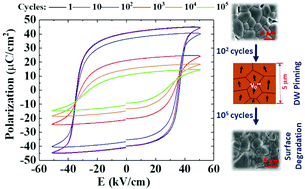Electrical fatigue behavior of NBT-BT-xKNN ferroelectrics: effect of ferroelectric phase transformations and oxygen vacancies†
Abstract
NBT-BT-based lead-free relaxors have attracted significant attention due to their excellent ferroelectric properties. They undergo a phase transformation to a ferroelectric state with domains, which plays an important role in their exhibited fatigue behavior. In case of non-ergodic relaxors (e.g. NBT-6BT) and ferroelectric compositions (e.g. NBT-12BT) domain wall pinning by oxygen vacancies leads to severe fatigue, while in case of ergodic relaxors (e.g. NBT-6BT-3(K1/2Na1/2)NbO3) domain wall pinning is relatively less effective. The importance of domain switching and concentration of oxygen vacancies has been further emphasized by comparing fatigue under unipolar and bipolar conditions, performing fatigue on NBT-6BT-3(K1/2Na1/2)NbO3 under non-ergodic (5 °C) and ergodic conditions (40 °C), and intentionally altering point defects concentration in NBT-6BT through non-stoichiometry. Furthermore, it has been shown that permanent fatigue due to electrode delamination and a blocking surface layer may commence at high numbers of fatigue cycles, depending upon the amplitude of fatigue waveform. Finally, the results obtained in this study have been summarized using a schematic.



 Please wait while we load your content...
Please wait while we load your content...